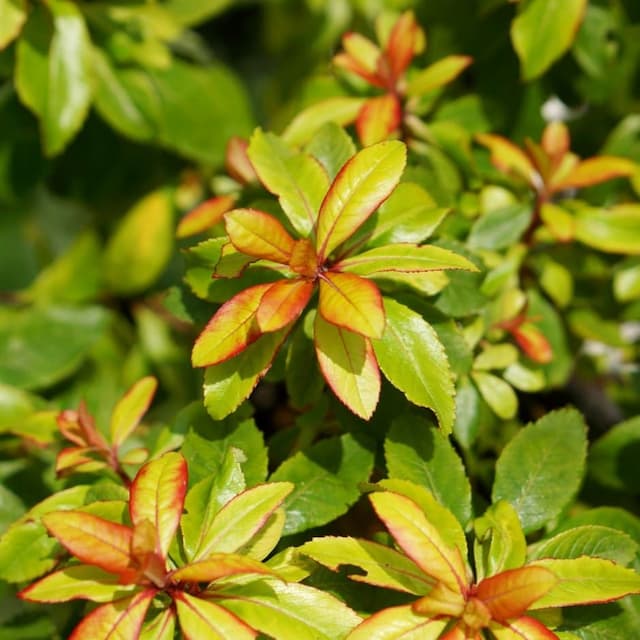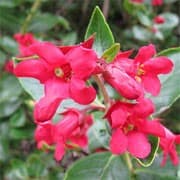Apple Blossom Escallonia Escallonia 'Apple Blossom'

ABOUT
Escallonia 'Apple Blossom' is a dense, evergreen shrub that features glossy, deep green leaves. The leaves are small and leathery with a toothed edge, adding a textured look to the bush. This plant is particularly admired for its abundance of flowers that bloom in clusters, reminiscent of apple blossoms. The flowers are delicate and bell-shaped, sporting soft pink petals with a blush white center and a slight fragrance that can attract pollinators like bees and butterflies. The blossoming period of this plant presents a profuse display of color and can add a romantic and whimsical touch to any garden space where it is planted. The overall appearance of Escallonia 'Apple Blossom' is lush and vibrant, with its combination of shiny foliage and pretty, pastel flowers creating an appealing visual impact throughout its flowering season.
About this plant
 Names
NamesFamily
Escalloniaceae
Synonyms
Apple Blossom Escallonia, Pink Escallonia
Common names
Escallonia 'Apple Blossom'.
 Toxicity
ToxicityTo humans
Escallonia 'Apple Blossom', commonly known as Escallonia, is not widely recognized as a poisonous plant to humans. There is limited information regarding its toxicity, and it does not typically appear on lists of toxic plants. However, it is always prudent to exercise caution and avoid ingesting plants that are not meant for human consumption, as individual sensitivities can vary. If a person were to ingest parts of this plant and experience adverse reactions, it is advisable to seek medical attention promptly.
To pets
Escallonia 'Apple Blossom' or simply Escallonia, to date, is not known to be toxic to pets such as dogs and cats. There is no widespread documentation of toxicity or symptoms associated with pets ingesting this plant. Despite the absence of recognized toxicity, it remains advisable for pet owners to prevent their pets from consuming non-food plants, as individual reactions can vary. If a pet does ingest Escallonia and shows signs of illness, a veterinarian should be consulted.
 Characteristics
CharacteristicsLife cycle
Perennials
Foliage type
Evergreen
Color of leaves
Green
Flower color
Pink
Height
6 feet (1.8 meters)
Spread
6 feet (1.8 meters)
Plant type
Shrub
Hardiness zones
8
Native area
South America
Benefits
 General Benefits
General Benefits- Attractive Flowers: Escallonia 'Apple Blossom' produces delicate pink and white flowers that add aesthetic appeal to gardens.
- Evergreen Foliage: Maintains its green leaves throughout the year, providing continuous foliage coverage.
- Drought Tolerance: Once established, it can withstand periods of low water availability, making it suitable for xeriscaping.
- Wildlife Friendly: The flowers attract bees, butterflies, and other pollinators, supporting biodiversity.
- Wind Resistance: It can act as a windbreak, thanks to its sturdy growth habit.
- Privacy Screening: Grows densely, which makes it suitable for creating privacy hedges or screens.
- Low Maintenance: Requires minimal care once established, which is ideal for gardeners seeking low-effort plants.
- Coastal Planting: Tolerant of salt spray, making it a good choice for coastal gardens.
- Fast Growing: Has a relatively quick growth rate, which allows for rapid establishment in the landscape.
- Pest and Disease Resistance: Resistant to many common pests and diseases, reducing the need for chemical controls.
 Medical Properties
Medical PropertiesThis plant is not used for medical purposes.
 Air-purifying Qualities
Air-purifying QualitiesThis plant is not specifically known for air purifying qualities.
 Other Uses
Other Uses- Escallonia 'Apple Blossom' can be used as a natural dye source; its flowers may provide subtle hues to fabrics or crafts.
- The plant can be crafted into living sculptures by skilled topiary artists due to its dense foliage and growth habit.
- It may serve as a privacy screen or hedge in residential landscapes owing to its bushy nature and fast growth.
- Escallonia 'Apple Blossom' can be used in floral arrangements for its dainty flowers and long-lasting greenery.
- Cuttings from the plant can be used for propagating new plants which can be given as eco-friendly gifts.
- It is ideal for coastal plantings because it tolerates sea spray and wind, making it useful in seaside gardens.
- The plant can be used as a companion plant in orchards to attract beneficial insects that help with pest control.
- When used in a sensory garden, the sweet scent of the flowers can provide an aromatic experience.
- The dense branches may serve as shelter and nesting sites for small birds and beneficial insects.
- Due to its evergreen nature, it can be utilized in festive wreaths and other holiday decorations during the winter season.
Interesting Facts
 Feng Shui
Feng ShuiEscallonia is not used in Feng Shui practice.
 Zodiac Sign Compitability
Zodiac Sign CompitabilityEscallonia is not used in astrology practice.
 Plant Symbolism
Plant Symbolism- Beauty: With its delicate pink and white blossoms, the Escallonia 'Apple Blossom' symbolizes beauty and grace, reflecting the attractive appearance of its flowers.
- Protection: Escallonia plants in general are known to be used for hedges and protective barriers, symbolizing protection and the creation of safe spaces.
- Resilience: This plant is adaptable to various conditions and resilient to coastal winds, symbolizing the ability to endure and thrive in challenging environments.
- Healing: Historically, some species of Escallonia have been used for medicinal purposes, which lends this plant the symbolic meaning of healing and therapeutic properties.
 Water
WaterThe Escallonia 'Apple Blossom', commonly known as the Escallonia, requires regular watering but it is important to avoid overwatering. During the active growing season in spring and summer, water the plant deeply once a week, providing approximately one to two gallons depending on the size of the plant and the weather conditions. Ensure the soil is moist but not waterlogged. Cut back on watering during the fall and winter to when the top inch of soil feels dry to the touch. Adjust the watering schedule based on rainfall, providing extra water during dry spells.
 Light
LightEscallonia thrives best in full sun to part shade conditions. Choose a spot where the Escallonia can receive at least six hours of direct sunlight daily. However, in areas with extremely hot summers, some afternoon shade can help prevent leaf scorch. It performs well in bright conditions but not in deep shade, as this can lead to reduced flowering.
 Temperature
TemperatureThe Escallonia is hardy and can tolerate a temperature range from about 15°F to over 100°F, although it grows best when the temperature remains between 65°F and 75°F. It prefers a moderate climate and may struggle in extreme cold without protection. In regions with severe winters, providing some form of frost protection, such as mulching around the base, is advisable.
 Pruning
PruningPruning the Escallonia is necessary to maintain its shape, encourage bushier growth, and enhance flowering. The best time to prune is in late winter to early spring before new growth starts. Trim away dead or damaged branches and cut back up to one-third of the older stems to stimulate new growth. Pruning can be done annually or as needed to control the size of the plant.
 Cleaning
CleaningAs needed
 Soil
SoilEscallonia 'Apple Blossom', commonly known as Apple Blossom Escallonia, thrives in well-draining soil enriched with organic matter. A mix containing loam, peat, and coarse sand can provide the ideal structure and nutrients. The soil pH should be slightly acidic to neutral, ranging from 6.0 to 7.5, to promote healthy growth.
 Repotting
RepottingApple Blossom Escallonia typically does not require frequent repotting. It should be repotted every 2 to 3 years, or when it has outgrown its current container, to refresh the soil and facilitate healthy growth.
 Humidity & Misting
Humidity & MistingApple Blossom Escallonia prefers moderate humidity levels. While it is not highly demanding in terms of moisture in the air, maintaining a humidity level of around 40-50% is usually sufficient for this plant.
 Suitable locations
Suitable locationsIndoor
Place in bright, indirect light, well-draining soil, moderate watering.
Outdoor
Full sun to partial shade, well-drained soil, mulch to retain moisture.
Hardiness zone
7-10 USDA
 Life cycle
Life cycleThe Escallonia 'Apple Blossom' starts its life as a seed, which, when sown in a fertile and well-drained soil mix, begins to germinate under the proper conditions of warmth and moisture. After germination, it enters the seedling stage, where it develops its first true leaves and establishes a root system. As it matures, the plant enters the vegetative growth stage, where it focuses on leaf and stem development to form a robust shrub. Upon reaching maturity, the Escallonia 'Apple Blossom' enters the flowering stage, typically in early to mid-summer, producing clusters of small, pinkish-white, fragrant flowers that attract bees and butterflies. After pollination, the flowers develop into small seed capsules, and once the seeds ripen, they are dispersed, allowing the cycle to begin anew. During its life, the plant may undergo pruning to shape and maintain a desirable size, as well as to remove any dead or diseased branches, encouraging fresh growth and flowering.
 Propogation
PropogationPropogation time
Spring-Early Summer
The most popular method of propagating the Escallonia 'Apple Blossom' is through semi-hardwood cuttings. This is typically done in the late summer when the current year's growth has started to woodify but is not yet fully hard. To propagate by cuttings, one would take a section of stem about 4 to 6 inches (10 to 15 cm) long, ensuring it includes at least two sets of leaves. The lower leaves are removed, and the cut is made just below a node. The cutting can be dipped in rooting hormone to encourage root growth and then planted in a well-draining soil mix. It should be kept in a warm location with indirect light and high humidity, such as under a plastic cover, until the roots have developed sufficiently to allow for potting on or direct planting in the garden.




